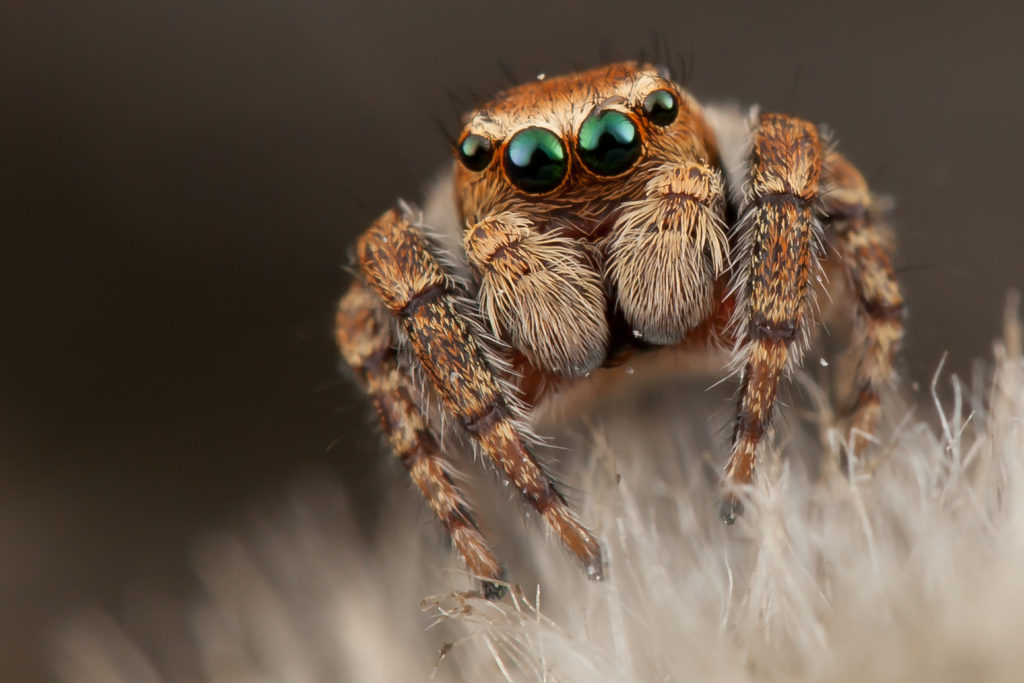Even in the lead up to Halloween, when we focus on spiders, they have a certain repugnance to them. Their long and dangly legs move and bend in a creepy fashion. Their sticky webs come from nowhere to entangle our hair and eyelashes. But then we see the jumping spider and everything changes. Why are jumping spiders so cute?
Fantastic Funnels
As humans, we tend to like things with big eyes and cuddly, fuzzy bodies. When it comes to the world of spiders, jumping spiders were fortunate enough to develop teddy bear characteristics.
The most obvious feature of a jumping spider is the two large pairs of eyes. They have 6 others, but it is the prominence and smoothness (sometimes colorful) of the eyes that make them cute rather than spooky. With regard to function, these large eyes act as a sort of telescope. They allow much more light to funnel in for focusing on more distant objects. This 4 pair eye setup helps them to have an excellent vision for hunting prey. They can’t focus their eyes like humans, but their multi-layered receptors allow for image defocusing and detection of distance.

Fuzzy Features
As with human males, some hair in some places is cute and attractive. Other hair is much less desirable. A nice full head of well-kept hair is good. Long, dark, pronounced back hair is typically less so. This seems to have a similar effect on spiders. The menacing and scratchy-looking hairs of a lynx spider do little to garner human affection. Jumping spiders, on the other hand, have a soft fuzzy, and colorful experience. They could have been part of anyone’s stuffed animal collection without any doctoring.
These hairs aren’t just to reduce the smash rates of their fellow hunters. Spider hairs aid them in hearing. These sensitive hairs pick up on vibrations that move through the air or other objects. Spiders use these cues in hunting, mating, self-preservation, and even determining the origin of the sound.
Locomotion
Typical spider locomotion is slow and awkward and creepy by nature. If it is a wolf spider that can really get up and go at high speeds, it may inspire fits of frenzy. The jumping spider has a different style of movement though. It typically moves along in short but quick jumps forward. The unique movement tends to have a captivating effect on its audience. Amazingly, a jumping spider can spring forward about 40 times its height when evading a death threat. It does this through an internal hydraulic system. If I could jump 200 feet forward, I would have many more admirers as well.
Dance Dance Dance
If all of the above wasn’t enough to pull you onto team jumping spider, consider their rhythm.
Jumping spiders have to convince their mate that they are:
- the right spider for procreation
- impressive enough to not be eaten after the fact
I’m pretty sure I would not make it as a jumping spider. My rhythm and natural instinct for the art of dance are dismal. Jumping spiders don’t even have a dance class they can attend. It is simply, dance impressively, or cease to exist. The one thing that they do have going in their favor is it appears to be more effort-based than anything.
Cute or Not, Here We Come
The more I study spiders and insects, the cuter they become. Despite that, I am keenly aware that most homes and businesses were intended to keep unwanted things out. Even a cute and cuddly opossum is unwelcome when it is hissing from your countertop. If you are seeing more spiders, insects or other witches brew arthropods than you would like; just give us a call. Rove Pest Control’s customer service team will customize a plan to keep things just how you want them. If anything goes awry, call us and we’ll be back to adjust and fix things up.
